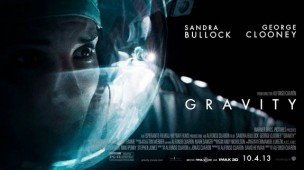
c/o www.space.com
It’s been a long seven years since Alfonso Cuarón released his exhilarating dystopian sci-fi “Children of Men.” His new film “Gravity,” however, is worth the wait. What it lacks in narrative creativity it makes up for in stunning visuals that frequently make the audience think, “How did they do that?” The result is a truly remarkable feat in the age of the Computer Generated Image.
The film opens with two astronauts, first-timer Dr. Ryan Stone (Sandra Bullock) and seasoned commander Matt Kowalski (George Clooney), as they fix a part on the Hubble Telescope. During their last space walk, Houston alerts them that debris from an anti-satellite test conducted by Russians has caused a chain reaction, taking down a number of satellites and sending the cumulative scrap metal racing toward their station. The communications go down and their lifelines are mangled. With only ninety minutes until the debris completes its orbit and returns, the two astronauts must find a ride back to earth.
“Gravity” successfully conveys the incomprehensible vastness and realities of space. Better than any film before it, “Gravity” fills viewers with the type of galactic dread usually reserved for IMAX documentaries. But don’t take my word for it—the King of Space himself James Cameron applauded the film in a recent Variety piece.
“I think it’s the best space photography ever done, I think it’s the best space film ever done, and it’s the movie I’ve been hungry to see for an awful long time,” Cameron told Variety.
As Bullock floats through space like Wall-E, she fails to find peaceful flight, but instead ceaselessy, violenty summersaults. The zero gravity was flawless and easily the highlight of the film, for good reason. Bullock spent between nine to ten hours a day in her filming rig, and, through her suit, was a virtual marionette controlled by strings. Still, while technically astonishing, “Gravity” is not perfect.
The little bits of storyline “Gravity” does have are all terribly cliché. One example is Bullock’s character, named Ryan because “my father wanted a boy.” But it works because she is tough, like a boy. Get it? There are also a few distracting references to other space movies that serve no purpose other than to remove you from the otherwise immersive “Gravity,” like when Bullock exits her space suit revealing a short haircut and a white tank top.
Even lamer is the “2001: A Space Odyssey” reference, when Bullock curls up like a fetus against a backdrop of Earth (mirroring the Kubrick film’s iconic final shot) for no apparent reason. I wonder how far you have to get in astronaut training before they teach you the fetal position. I’m also worried for Ed Harris after seeing “Gravity.” He seems to have never left the NASA control phone in the 18 years since “Apollo 13” came out.
Ultimately, these criticisms are nitpicking. “Gravity” is not meant to be a character study; it’s supposed to be an intense, visceral, mostly-realistic look at the countless ways space can kill us humans. In this regard, “Gravity” more than delivers, summoning a hefty amount of breathtaking and exhilarating shots. It’s the type of film that isn’t watched; it’s experienced.
1 Comment
Wallawallabingbang
Well… it’s no Event Horizon